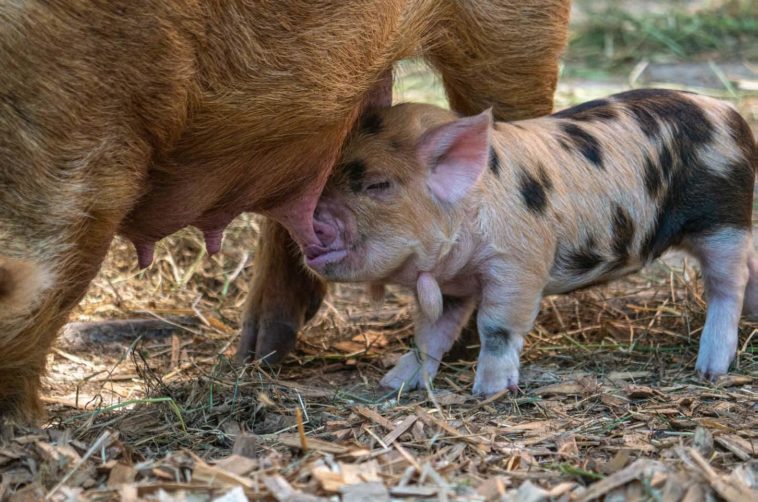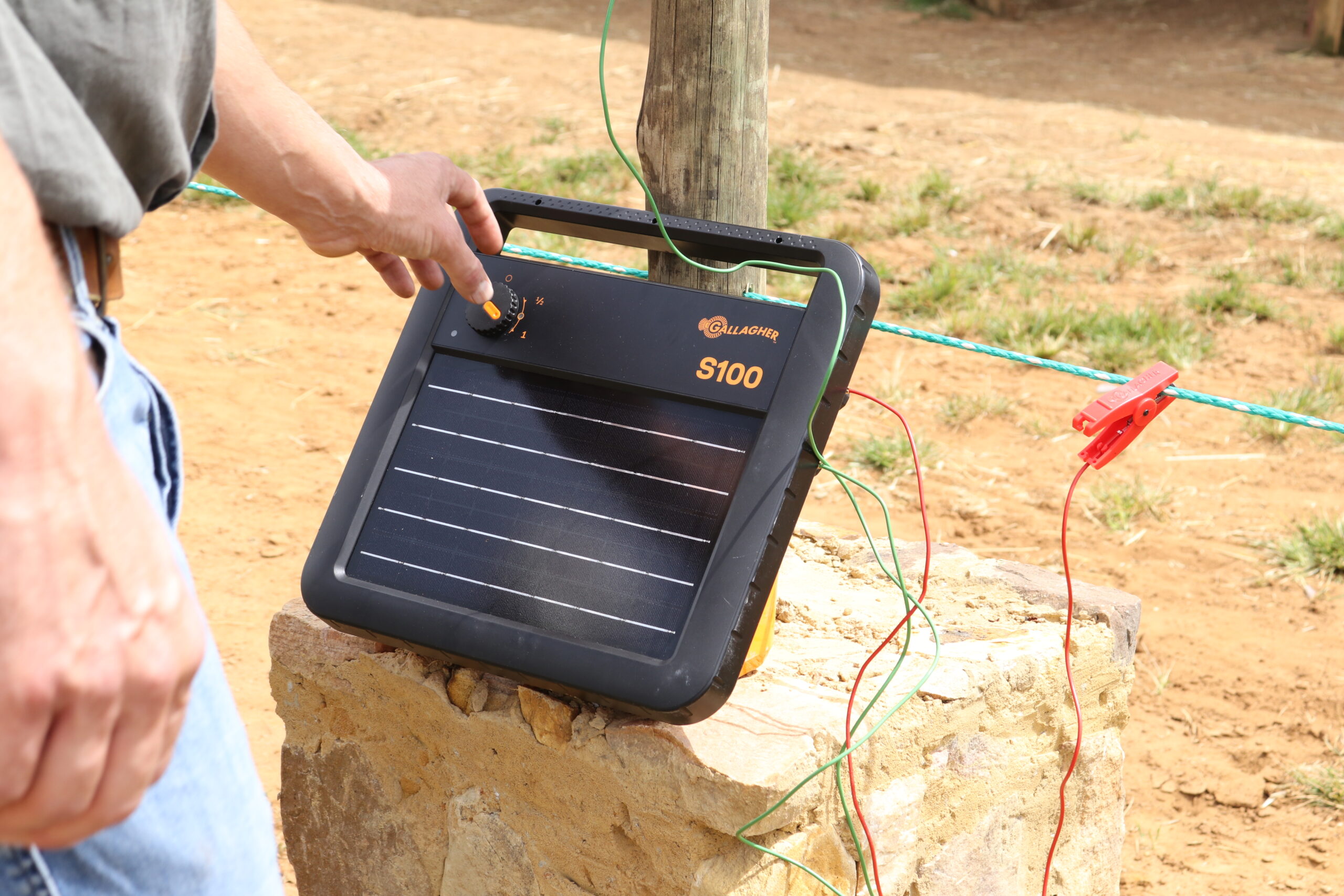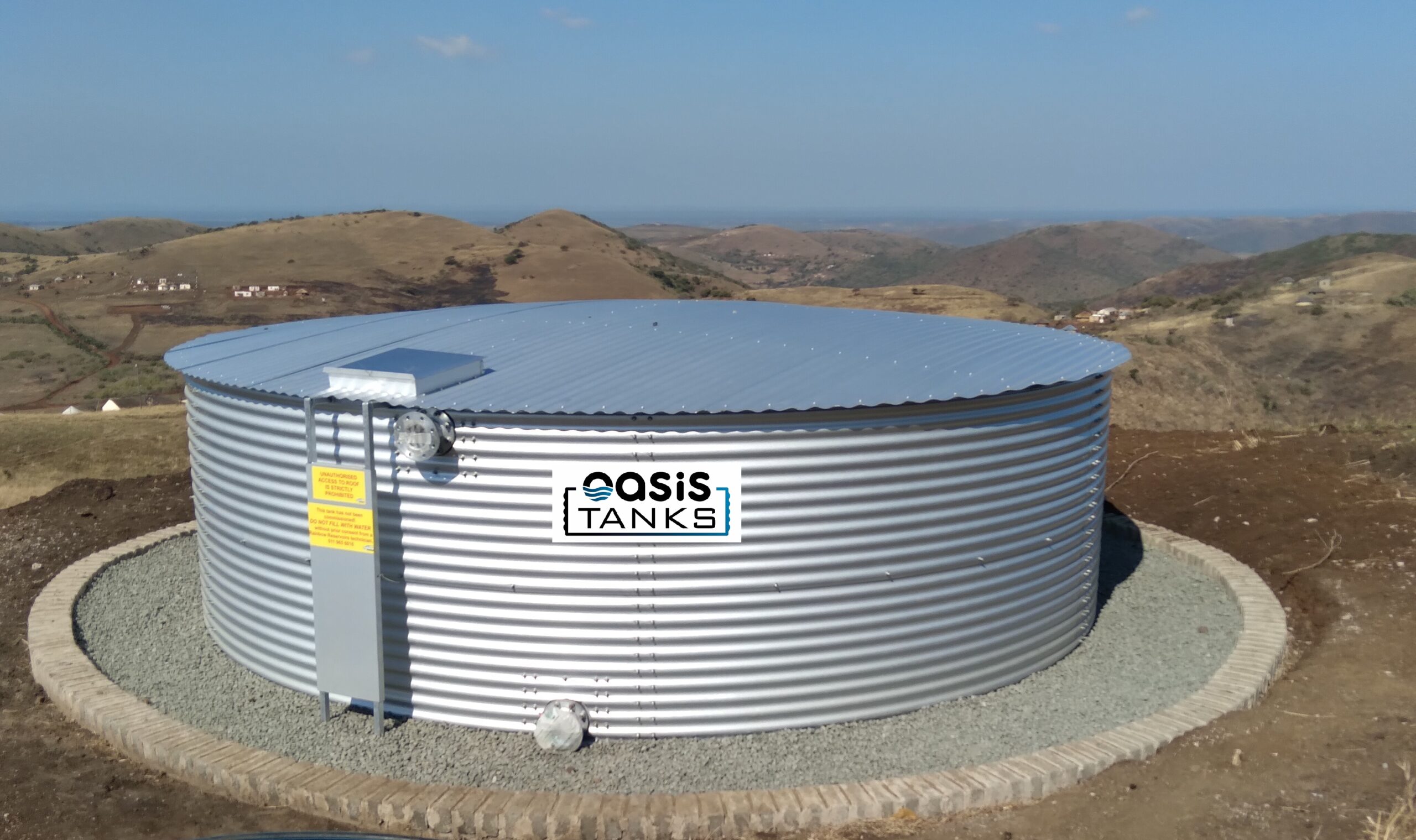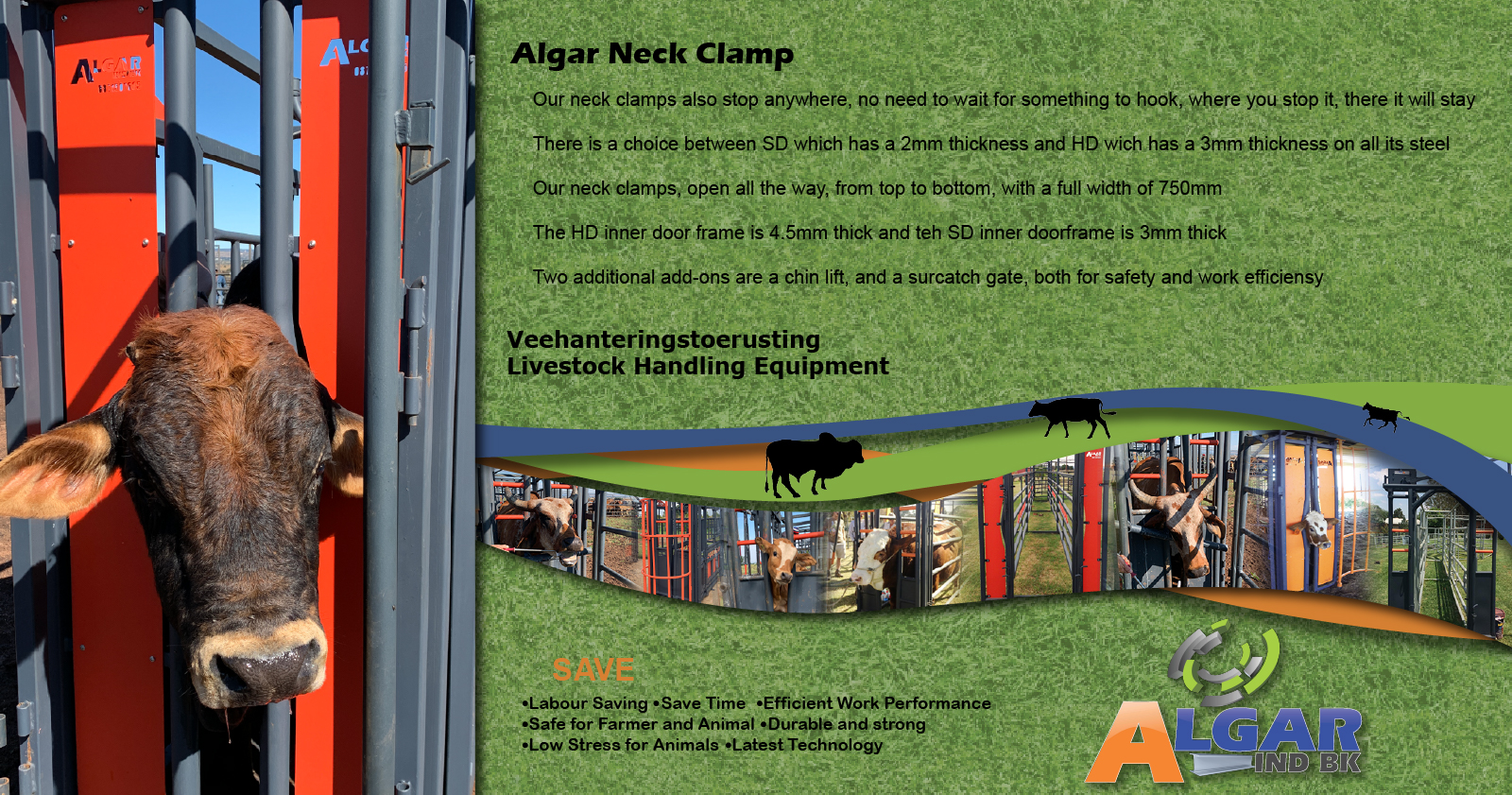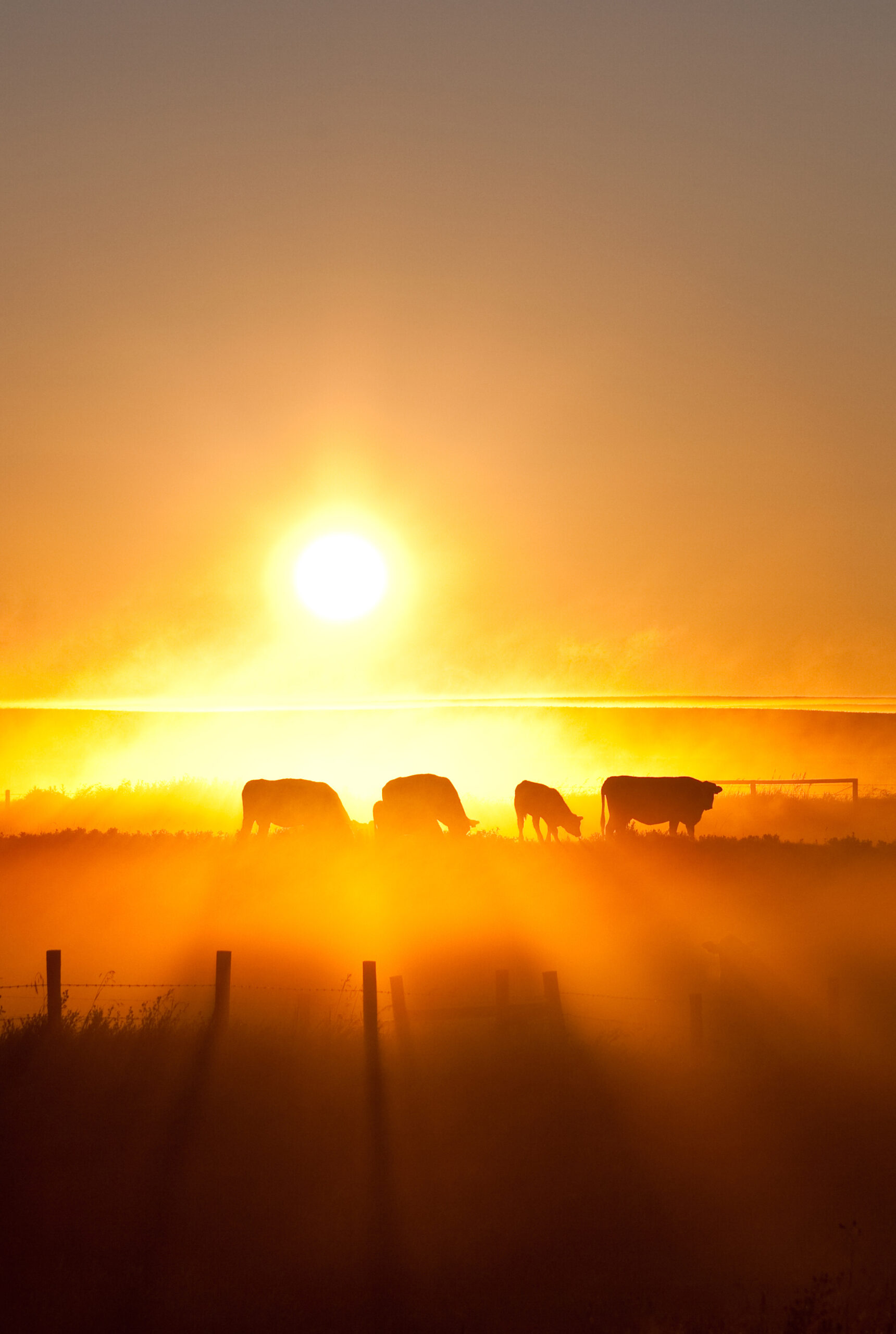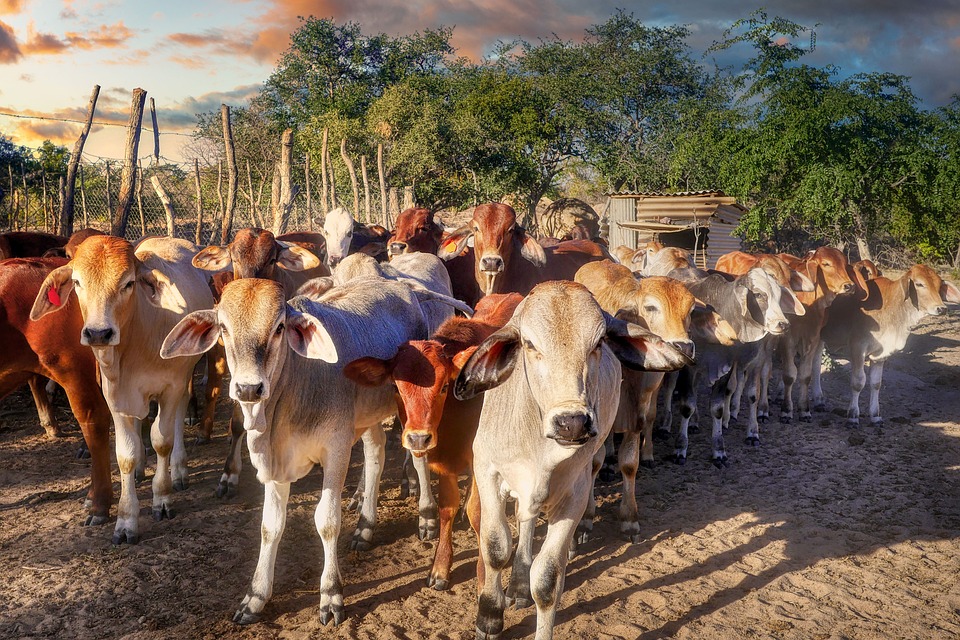The management of a business plays a crucial role in its success or failure. Even more so when dealing with livestock. Managing the different types of feed of animals at different ages, keeping up with the tasks that need to be performed during the stages of production and record keeping are among the vital aspects of pig production. This guide will provide you with some helpful hints on managing your pig farm properly.
Piglets from birth to weaning
Almost 50% of the pigs that die on a farm die before they are 14 days old. Good management in the farrowing house, where the piglets are born and kept for the first 28 to 35 days of their lives is therefore of utmost importance. Remember to keep the piglets dry and in a draught-free pen or box where the temperature is high and does not change much.
The farrowing pen must be designed in such a way that the sow cannot lie on top of the piglets. New-born piglets are very sensitive to cold, draughts, wet bedding and floors as well as sudden changes in temperature. Ensure therefore that everything possible is done to prevent piglets from being exposed to these conditions.
A farrowing crate for the sows and a creep area for the piglets should be provided to prevent or reduce deaths as a result of piglets being trampled by the sow or as a result of cold, draughts, etc. Make sure that all piglets suckle a teat as soon as possible after birth to take in colostrum. The first milk produced by the sow immediately after the piglets are born is known as colostrum. It plays an important role in the protection of the piglets against diseases during the first few weeks of their lives.
If a sow has more piglets than the number of teats she has, the extra piglets can be placed with another sow with a smaller number of piglets. This can only be done if the piglets of the sows are born within a few days of each other. Sometimes a sow does not accept her own piglets, usually as a result of birth shock. If this happens, the piglets can be taken away from the sow for a few hours. If she still refuses to accept them, they should be placed with another sow if possible. Sows that do not accept their piglets or bite them, must rather be slaughtered.
If another sow is not available to rear the rejected piglets, they can be reared artificially. It does, however, take time and hard work, because the piglets do not always grow and perform well. Feed the piglets small quantities every 2 to 3 hours. Start by giving 50 ml each time they are fed, so that each piglet takes in 350 ml per day. Gradually increase the quantity to about 100 ml so that each piglet gets 750 ml at three weeks of age. Provide creep meal in a shallow dish or on the floor from two weeks onwards to encourage the piglets to eat meal as soon as possible.
Fresh, clean water must always be available in a shallow dish. The piglets should drink water as soon as possible.
The bedding in piggeries need to be changed often and kept clean and dry to ensure healthy, growing pigs.
Management of the specific treatment of piglets
Umbilical cord
Disinfect the umbilical cord after birth with an iodine solution or any other suitable disinfectant to prevent bacterial infection.
Tusk clipping
Piglets have very sharp temporary tusks (or teeth) at birth which must be clipped to prevent injuries to the teats of the sows during suckling. Use a tusk clipper and do not clip the teeth too close to the gums.
Iron injections
The milk of the sow does not provide enough iron to piglets that are reared on concrete floors. Piglets must therefore be injected with iron when they are three to seven days old to prevent them from becoming anaemic which results in poor appetite and growth until they start eating meal. In order to handle the piglets as little as possible, clip the tusks and give the iron injection at the same time, about three days after birth.
Water and feed
Clean, fresh water placed at the back of the pen where the piglets will learn to dung is very important. The sooner they start to drink water the better. Two to three weeks after birth they will start to nibble on feed placed away from the water near the creep area. Creep feed is expensive, and they will not eat much before weaning, therefore only small quantities of feed must be given from two to three weeks of age. Increase the daily quantity gradually when they start eating to prevent wastage.
Sow management
Good management is necessary to produce a maximum number of pigs that can be sold per sow in one year’s time at a maximum profit for the farmer. The management skills of the farmer determine to a large extent how many piglets are reared, how long it takes to rear them to market weight and the cost involved.
A farmer with good management skills will:
- Feed his pigs correctly, which means that he will have to know what and how much the pigs must be fed.
- Build pig houses that are efficient and planned in such a way that management is made easier.
- See to it that the pig houses and pigs are kept clean under hygienic conditions to prevent and control diseases.
- Use good breeding material that will breed pigs that are able to grow fast, have carcasses with well-developed muscles (meat) with as little fat as possible and use their feed efficiently.
- Supervise daily and keep records so that it will be easy to make sure that everything that needs to be done is carried out.
Pregnant sows
Sows come on heat every 21 days. A sow served by a boar is not always pregnant. The sow must be brought to a boar again 19 days after she has been served for three to seven days to make sure that she becomes pregnant.
Sows that come on heat for a second time should again be served. Sows that regularly come on heat after service by a boar must rather be slaughtered. Pregnant sows must be free of internal parasites. Parasite infections will affect the health of the sow as well as her feed intake. The sows can also infect the piglets. Parasite eggs that are excreted in the dung can be eaten by the piglets. Deworm pregnant sows 21 to 28 days before they have their piglets (piglets are born 116 days after service).
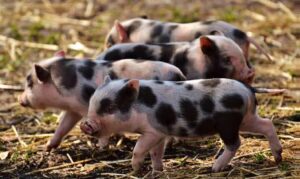
Piglets exploring.
Management during farrowing
The farrowing houses
Piglets have a low resistance to infections. The farrowing houses must preferably be situated some distance from the other pig houses and a high standard of hygiene must be maintained. Wash and scrub the farrowing pen properly every time the sow and piglets are removed. Disinfect the pen and leave it to dry for a period of two to three days before placing a sow in it. When a sow and her piglets are in a pen, it must be kept as dry as possible. Use as little water as possible for daily cleaning. Dirty and wet bedding must be removed daily.
The sow
Wash and disinfect the sow before putting her in the farrowing pen four to five days before the piglets are born. Young female pigs that are about to farrow for the first time must get used to their pen. Therefore, put them in the farrowing crate for a few hours per day from about 10 days before farrowing so that they can become accustomed to it. To prevent sows from becoming constipated during this period, green feed such as lucerne or a high-fibre feed, such as bran can be fed. Feed 1 kg bran when they are put in the farrowing crate for the four days before farrowing.
Farrowing
The sow becomes restless and starts to “make a nest” with the bedding in the crate when she is ready to farrow. Swelling of the vulva is a sign that she is ready to give birth. Supervision during the birth process is necessary, especially when it is a sow giving birth for the first time. When the piglets are born, make sure that they do not get entangled in birth membranes and that they do not suffocate in mucus or amniotic fluid. Keep the sow calm so that she does not trample the piglets to death. Piglets usually break the umbilical cord which joins them to the sow. If weak piglets do not break the cord themselves, it is advisable to break the cord with the thumb and forefinger.
During the first week after farrowing it is important to pay attention to the following:
- Check that the sow is not constipated.
- The afterbirth must be discharged from the sow as soon as possible.
- The sow should not develop a fever as a result of infection.
- Look out for milk fever during the first few (4 to 6) days after farrowing.
- Look out for the development of mastitis that results in hard and inflamed (red) teats.
- Mastitis and a lack of milk (agalactia) can cause the piglets to die of hunger. Immediate attention by a veterinarian is therefore necessary.
Management during lactation
There is a large difference in the environmental temperature requirements of sows and piglets. Sows must feel comfortable. Very high temperatures will cause the sows to eat less and lose weight. Lactating sows (sows with piglets) will produce less milk for the piglets, so that the piglets will grow slower.
If they lose too much weight, they will also take longer to come on heat after weaning, which means a delay before the next pregnancy period. High temperatures are, however, needed for the piglets, particularly for the first seven to ten days after birth. A dry, draughtfree creep area (or box) where they can lie is therefore very important.
Diarrhoea can be a problem in piglets. If the quantity of feed fed to the sow is increased too soon after farrowing, it can cause diarrhoea. If the piglets get diarrhoea, do not feed the sow for a day. If the condition does not improve, a bacterial infection can be the reason. The piglets should then be treated with antibiotics.
As a general guideline, the temperature in the farrowing house should preferably be 16 to 20 °C and in the creep area as high as 28 to 32 °C
Other management aspects
Clean, cool water must always be available for the sow. Provide enough food for the sow, preferably as much as she wants to eat so that she does not lose weight while suckling her piglets. Inspect the sow’s udder regularly (preferably daily) for hard lumps (signs of infection). If lumps are found, treat the sow immediately. Clean the farrowing pen daily. Wean the piglets when they are four weeks but not more than five weeks old. Wean the piglets by taking the sow away from the litter (piglets).
Move the piglets to the growing pens seven days later. Sows come on heat again three to five days after weaning. Therefore, take them to the boar from three days after weaning once a day until they are served. Sows must receive less feed (about 2 kg a day) from the day after weaning.
Management from weaning to slaughter
Clean water and feed in a trough, preferably a self-feeder, must be available to the piglets after weaning. Piglets sometimes tend to eat too much for a day or two after weaning. This can cause diarrhoea that can be stopped by providing less feed for a few days.
If it continues, it may be a bacterial infection and must be treated with an antibiotic. Antibiotics can be mixed into the feed or given, dissolved in water, by way of a teat attached to a plastic bottle fastened to the wall or gate. It is advisable to treat the litter for internal parasites soon after weaning. Always keep the piglets of the same sow together by moving them to the same growth pen seven days after weaning.
Piglets coming from different litters will fight one another when placed in the same pen. If it is necessary to put pigs from different sows in the same pen, try to put those of the same size and type together. Do not put one or two new pigs in a large group. Put all the pigs in a new pen that is unfamiliar to them. Spray the pigs with a solution with a distinctive smell.
Growing pigs must grow as fast as possible and therefore they must eat as much as possible of the right feed mixture without becoming too fat. A suitable self-feeder that ensures that every pig can eat as much as it wants, without wasting feed, is therefore very important. Growing pigs can be sold as porkers when they weigh 60 to 70 kg and are between 15 and 18 weeks old, or as baconers when they weigh 86 to 90 kg and are just less than six months old. Transport pigs to the market when it is cool, e.g. early in the morning or late afternoon. There must not be too much moving space on the vehicle.
Cannibalism
Conditions in the growing pen that are unfavourable such as cold, draughts, concrete floors without bedding, not enough eating space and poor ventilation can cause stress to the pigs. Pigs bite one another’s tails when stressed. This leads to cannibalism and continued tail biting. Pigs with injured tails grow slower and may even die if the injuries become more severe. Injured pigs must therefore be removed from the pen, and the wounds disinfected and treated with an antibiotic.
Record keeping
Keeping records helps the farmer to manage his pigs effectively and to know which pigs to select for breeding. All breeding animals should be marked permanently by using an ear-number system so that records can be kept for each animal.
Records for each sow for the following should be kept:
- The date that the sow is served so that it is possible to know when she must come on heat again if she is not pregnant, or to know whether she is pregnant when she does not come on heat 20 to 25 days after service.
- The expected farrowing date so that she can be brought to the farrowing house three to four days before she is due to farrow.
- The weaning date so that the piglets can be weaned on the right date and that the sow is brought to the boar again for service from three days after weaning. This will also indicate which sows to cull (those that do not come on heat or those that are on heat again within about three weeks).
- The age of the sow and how many litters she has had so that sows that get too old can be culled.
- The litter size (number of piglets) must be recorded. The total number born, the number born alive, the number born dead and the number of piglets that die between birth and weaning. These records will give an indication of problems concerning fertility or disease.
- The records kept will help to select females to be used as sows for future breeding from big litters and sows that farrow regularly. It is important that sows produce at least two litters every year.
Record keeping will also aid in the biosecurity of the farm, which is an extremely important aspect of pig rearing.
We thank the South African Department of Agriculture for the information provided to the readers of Botswana, Namibia and Zimbabwe in this article series. For more information visit their website at https://www.daff.gov.za/.

